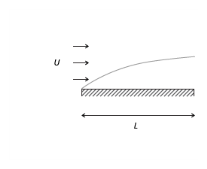where Pr = μCp ⁄ k and
ReL = ρUL ⁄ μ. The plate length,
L, and the exterior velocity,
U, are correlation inputs. The material data are evaluated at
(T + Text) ⁄ 2.
The laminar-turbulent transition at ReL = 5.105 is handled by the use of a smoothed Heaviside function with a transition of size
5.104, which corresponds to 10% of the threshold value.
where Pr = μCp ⁄ k and
Rex = ρUx ⁄ μ. The correlation inputs are
x, the position along the plate, and
U, the exterior velocity. The material data are evaluated at
(T + Text) ⁄ 2. To avoid division by zero when the position along the plate is located at the origin point (
x = 0), the implementation replaces
k ⁄ x by
k ⁄ max(x, √ε) where
ε is the floating-point relative accuracy.
The laminar-turbulent transition at Rex = 5.105 is handled by the use of a smoothed Heaviside function with a transition of size
5.104, which corresponds to 10% of the threshold value.
where Pr = μCp ⁄ k and
ReD = ρUD ⁄ μ. The cylinder diameter,
D, and the exterior velocity,
U, are correlation inputs. The material data are evaluated at
(T + Text) ⁄ 2.
where Pr = μCp ⁄ k and
ReD = ρUD ⁄ μ. The sphere diameter,
D, and the exterior velocity,
U, are correlation inputs. All material data are evaluated at
Text except
μs, which is evaluated at the wall temperature,
T.
